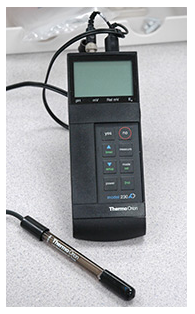Archival Notice
This is an archive page that is no longer being updated. It may contain outdated information and links may no longer function as originally intended.
Home | Glossary | Resources | Help | Contact Us | Course Map
Basic Acid – Base Chemistry
Acid Definitions:
- Brønsted-Lowry – a compound capable of donating hydrogen ions
- Lewis – a compound that can accept an electron pair from a base
- Arrhenius – a compound that releases hydrogen ions in solution
Base Definitions:
- Brønsted-Lowry – a molecule or ion that accepts hydrogen ions from solution
- Lewis – a molecule or ion that donates an electron pair to an acid
- Arrhenius – a compound that releases hydroxide ions in solution
Acid – Base Reactions
- Neutralization
- The neutralization reaction of acid and base results in water and salt.
- H+ (aq) + OH- (aq) → H2O
- Examples of acid – base reactions:
- HBr + KOH → H2O + KBr
- HCl + NaOH → H2O + NaCl
In keeping with the Brønsted-Lowry definitions of acids and bases, the criterion is the concentration of hydrogen ions present. Acids are proton donors and bases proton acceptors. The pH scale denotes the acidity or basicity of something through measurement of hydrogen ion concentration.
Given pH = -log [H+], a solution where [H+] = 1 x 10-7 moles/liter is of pH 7. Thus, solutions with lower pH designations are more acidic, and those with higher pH are more basic. Ranging from pH 0 (e.g., HCl) to pH 14 (e.g., NaOH), pH 7 is considered neutral. Acidic and/or basic solutions may require titration to a desired pH through the addition of acid and/or base. Thus, the pH meter is a tool in determining the pH of the solution in question.
pH Meters
pH meters utilize a probe bearing a thin glass bulb at the tip. Two electrodes inside the probe measure voltage. One electrode is contained within a liquid of fixed pH, while the other is free to respond to the [H+] of the sample. The voltage difference is measured by a voltmeter and translated into pH. Trainees must be able to properly care for, calibrate, and use the pH meters available in the laboratory before making reagents. Most pH meters are readily calibrated using standard pH solutions available from the manufacturer or a variety of suppliers; however these are not traceable to a national standard of measurement so the laboratory must provide satisfactory evidence of correlation of results.
Additional Online Courses
- What Every First Responding Officer Should Know About DNA Evidence
- Collecting DNA Evidence at Property Crime Scenes
- DNA – A Prosecutor’s Practice Notebook
- Crime Scene and DNA Basics
- Laboratory Safety Programs
- DNA Amplification
- Population Genetics and Statistics
- Non-STR DNA Markers: SNPs, Y-STRs, LCN and mtDNA
- Firearms Examiner Training
- Forensic DNA Education for Law Enforcement Decisionmakers
- What Every Investigator and Evidence Technician Should Know About DNA Evidence
- Principles of Forensic DNA for Officers of the Court
- Law 101: Legal Guide for the Forensic Expert
- Laboratory Orientation and Testing of Body Fluids and Tissues
- DNA Extraction and Quantitation
- STR Data Analysis and Interpretation
- Communication Skills, Report Writing, and Courtroom Testimony
- Español for Law Enforcement
- Amplified DNA Product Separation for Forensic Analysts


